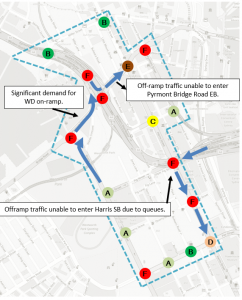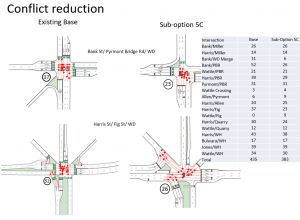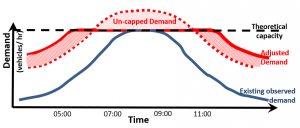Building a case to improve traffic on one of Sydney’s most congested road networks
Roads and Maritime Services (RMS) is investigating road corridor improvements to support a once-in-a-generation transformation of the Bays Precinct, and to manage congestion in the city centre.
The Bays Precinct Pyrmont Traffic Improvements (PTI) investigation is a traffic network modelling study that supports a strategic business case to identify problems and develop solutions to reduce traffic congestion. Our focus was to improve traffic on some of Sydney’s most congested roads, critical intersections and pinch points.
The Pyrmont-Ultimo is the most densely populated suburb in Sydney with a population density of 15,346 people per square kilometre (Australian Bureau of Statistics 2016). It is a key transport hub which connects the Western Distributor to important locations in the CBD south such as TAFE Ultimo and the University of Technology Sydney.
A comprehensive options testing process was undertaken using SIDRA Network modelling to optimise intersection and road network operations within constrained geometric footprints and with significant forecast traffic volumes.

Detailed Modelling
We developed SIDRA Network models with congestion, connectivity and confidence in mind. This avoided us having to rework our base models and provided a good foundation from which we could undertake cost effective and reliable options testing.
The models underwent a rigorous calibration and validation process (in accordance with RMS Modelling Guidelines) using multi-source traffic data.
TMA worked collaboratively with RMS to develop a number of design options, utilising the previous findings from earlier options to reach the final revision and recommended option.

Road and Intersection Feasibility
As part of our aim to improve network performance improve road safety along the corridor, we reduced the number of conflict points at intersections by 12% in constrained geometric footprints. This results in increased throughput reduced integreen and pedestrian clearance times and improved overall safety of the road network.

Demand Management
We integrated strategic model sub-area matrices WRTM (WestConnex Road Traffic Model) for demand development through disaggregation of travel zones for fine-grained assignment utilising an intermediate microsimulation model that accounts for upstream/downstream capacity constraints.
Capturing the value from strategic models, we developed a robust methodology for applying forecast traffic growth to observed traffic volumes that makes allowance for poor localised calibration of intersection turning movement volumes within the strategic models.

Bus network implications
As some of the options involved reconfiguration of the arterial road network, we examined bus services and potential re-routing options to maintain, as far as practical, existing bus service levels and patronage. We provided high level insights on optimal re-routing and provided quantitative analysis using Sidra to assist in evaluation of designs and decision making.

Results
We discovered that the initial options provided by RMS were unsuitable for the future road network because they achieved poor levels of service for traffic. We worked with RMS to revise its earlier conclusions and make a final recommendation for a better option.
Our modelling revealed that one option was the best performing future road network arrangement for this area.
Our report also highlighted concerns with applying traffic demand volumes derived from the WRTM for use in operational modelling. For example, the outputs from the WRTM indicate significant demands entering the Pyrmont-Ultimo network for the forecast year of 2031, which may not be able to enter the broader road network during peak periods.
From our assessment, we recommended that the RMS:
- Investigate the design and feasibility of one particular option and take forward for detailed design
- Examine how to better reflect practical demands derived from the WRTM for use in operational modelling.

